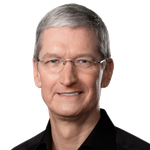
Apple Inc
NASDAQ:AAPL

Apple Inc





Apple Inc., borne out of the innovative spirit of Steve Jobs, Steve Wozniak, and Ronald Wayne in a modest garage, has steadily crafted its journey from a fledging startup to a titan of technology. This evolution is marked by a unique blend of creativity, innovation, and marketing genius. Apple reimagined personal computing with its introduction of the Macintosh in 1984, changing the way individuals and businesses interacted with technology. Over the years, the hallmark of its success has been the seamless integration of its hardware, software, and services—an ecosystem that captivates customers and locks them into its universe. With each product launch, from the iPod to the iPhone, Apple adeptly combined sleek design and intuitive functionality, setting new industry benchmarks and redefining the consumer electronics landscape.
The company's prowess extends beyond product innovation to commanding a global supply chain and retail strategy that reinforces its market dominance. By establishing its retail stores as experiential havens, Apple offers more than just products; it provides an immersive brand experience. Financially, Apple thrives through a trifecta of product sales, services, and rigorous supply chain efficiency. The iPhone remains a substantial revenue driver, complemented by the growth of connected devices like the Apple Watch and AirPods. Meanwhile, its burgeoning services segment—encompassing the App Store, iCloud, Apple Music, and more—continues to expand margins and enhance customer loyalty. This services layer not only augments Apple's top-line but also deepens its engagement with consumers, reflecting a well-engineered strategy to sustain its competitive advantage and foster long-term growth.
Earnings Calls
Apple's Q2 FY2025 earnings report reveals a revenue of $95.4 billion, up 5% year-over-year, driven by a record $26.6 billion in services—growing 12%. iPhone revenue rose to $46.8 billion, aided by the new iPhone 16e model. Gross margin was at 47.1%, with expectations of 45.5% to 46.5% for the next quarter, amid a $900 million tariff impact. Apple plans to invest $500 billion over four years, focusing on manufacturing expansion in the U.S. As for guidance, June quarter growth is projected at low to mid-single digits, indicating cautious optimism amidst macroeconomic uncertainties.
Management

Timothy D. Cook is the Chief Executive Officer (CEO) of Apple Inc., a position he has held since August 24, 2011, succeeding the company's co-founder Steve Jobs. Cook originally joined Apple in 1998 as Senior Vice President for Worldwide Operations and later served as Executive Vice President for Worldwide Sales and Operations. His strategic vision and expertise in supply chain management were significant in helping Apple streamline its operations, reduce inventory, and improve margins. Born on November 1, 1960, in Mobile, Alabama, Cook graduated from Auburn University in 1982 with a Bachelor of Science degree in Industrial Engineering. He later earned a Master of Business Administration (MBA) from Duke University's Fuqua School of Business in 1988. Under Cook's leadership, Apple has continued to grow its product line and maintain its status as a leader in technology and innovation. He has overseen the development and launch of significant new products like the iPhone X, Apple Watch, and AirPods, and has emphasized Apple's commitment to privacy, renewable energy, and ethical manufacturing practices. Cook is also known for his advocacy on social issues such as privacy, immigration, and LGBTQ rights, being one of the most prominent openly gay CEOs of a major company. Cook's approach has been more focused on operational excellence and incremental improvements to products and services, ensuring the company maintains its strong financial performance and brand reputation while fostering a culture of innovation. Throughout his tenure, Tim Cook has been credited with substantially increasing Apple's market value, turning it into one of the most valuable publicly traded companies globally. His leadership style is often described as calm and collected, with a strong focus on collaboration and sustainability.

Luca Maestri is the Chief Financial Officer (CFO) and Senior Vice President at Apple Inc. He joined the company in 2013 and was appointed CFO in May 2014. In his role, Maestri is responsible for overseeing Apple’s accounting, business support, financial planning and analysis, treasury, investor relations, internal audit, and tax functions. Before joining Apple, Maestri had a distinguished career spanning over 25 years in global finance and senior management. He worked at Xerox Corporation as CFO, where he was responsible for the company’s financial strategy and operations globally. Prior to Xerox, Maestri served as CFO of Nokia Siemens Networks. His career also includes a lengthy tenure at General Motors, where he held various financial and operational roles across the globe, including assignments in Asia-Pacific, Europe, and Latin America. Luca Maestri was born in Italy and holds a bachelor’s degree in Economics from Luiss University in Rome and a master’s degree in Science of Management from Boston University.

Katherine L. Adams is the Senior Vice President and General Counsel at Apple Inc. In this role, she oversees all legal matters for the company, including corporate governance, intellectual property, litigation, and compliance, among other responsibilities. Adams joined Apple in 2017, bringing with her a wealth of legal experience and expertise. Before her tenure at Apple, Adams served as Senior Vice President and General Counsel for Honeywell International, where she led the company’s global legal strategy across its various business sectors. Her career also includes working at Sidley Austin LLP, a prestigious law firm, where she was a partner focusing on complex litigation issues. Adams holds an undergraduate degree in comparative literature from Brown University and a Juris Doctor degree from the University of Chicago Law School. Her diverse background and leadership have made her an influential figure in the tech industry and an integral member of Apple's executive team.

Deirdre O'Brien is a prominent executive at Apple Inc., where she serves as the Senior Vice President of Retail + People. She has been with the company for over three decades, having joined Apple in 1988. O'Brien plays a crucial role in overseeing both Apple's retail operations and the human resources functions. Her responsibilities include managing Apple's global retail presence, which involves ensuring a seamless customer experience across all Apple Stores. Additionally, as head of People, she is instrumental in fostering a positive workplace culture, focusing on employee engagement, development, and inclusion. O'Brien holds a Bachelor of Arts in Operations Management from Michigan State University and an MBA from San Jose State University. Her long-standing tenure at Apple has seen her contribute significantly to the company's growth and success across various departments. Known for her leadership and dedication, O'Brien continues to be a key figure in maintaining Apple's reputation as an innovative and employee-friendly company.

Chris Kondo is a senior director who works in Apple's corporate law division with a focus on financial compliance. He is often seen representing Apple in financial matters and during quarterly earnings calls. Kondo plays a significant role in ensuring that Apple's financial disclosures are accurate and comply with regulatory standards. His work involves interfacing with investors, analysts, and stakeholders to provide transparency and insights into Apple's financial performance. Through his position, Chris Kondo contributes to maintaining Apple's reputation for financial integrity and regulatory compliance.


Greg Joswiak, commonly known as "Joz," is a prominent executive at Apple Inc. He has been with the company for several decades, contributing significantly to Apple's marketing and product strategy. Joswiak is known for his expertise in product marketing and has played a crucial role in the development and launch of numerous Apple products. Joswiak started at Apple in 1986, and over the years, he has held various positions within the company. He has been instrumental in shaping the marketing strategies for key products such as the iPhone, iPod, and iPad. Known for his deep understanding of Apple's consumer base and market dynamics, he has helped ensure the success of Apple's product lines through innovative marketing approaches and a strong focus on user experience. In recent years, Greg Joswiak has served as the Senior Vice President of Worldwide Marketing, a role in which he is responsible for Apple's global product management and marketing communications. He leads the team that drives Apple's renowned product launches and advertising campaigns. His leadership continues to be a driving force in maintaining Apple's brand as one of the most iconic and influential in the tech industry. Joswiak has played a substantial role in maintaining Apple's legacy of creating cutting-edge technology products while ensuring they are accessible and appealing to a broad audience.

Adrian Perica is a prominent executive at Apple Inc., serving as the Vice President of Corporate Development. He plays a critical role in Apple's strategic acquisitions and investment activities. Since joining Apple in 2009, Perica has been instrumental in orchestrating several key deals that have helped shape Apple's technological and market landscape. Prior to his role at Apple, Adrian Perica worked at Goldman Sachs, where he gained significant experience in mergers and acquisitions. His financial expertise and strategic acumen have been vital in identifying and negotiating acquisitions that align with Apple's long-term goals. He has led efforts to acquire companies that bolster Apple's technological innovations and market position, contributing to the development of products and services across the company's ecosystem. Throughout his career, Perica has been recognized for his ability to align acquisitions with Apple's vision, ensuring that new technologies and talent are integrated smoothly into the company's operations. His work continues to support Apple's growth and innovation in the competitive tech industry.

Michael Fenger is a high-profile executive at Apple Inc., serving as the Vice President of Product Marketing. In his role, he is responsible for spearheading strategies that enhance Apple's global reach and influence in the consumer electronics market. He plays a crucial part in defining product visions, marketing strategies, and overall market positioning for Apple's diverse product range, including the iPhone, iPad, Mac, and Apple Watch. Fenger is known for his strategic acumen and deep understanding of market dynamics, contributing to Apple's impressive growth and sustained leadership in innovation. His insights and leadership help shape product launches, ensuring that Apple's offerings not only meet but exceed customer expectations. Throughout his career at Apple, he has been instrumental in driving branding initiatives and expanding market penetration, demonstrating a commitment to maintaining Apple’s reputation for excellence and cutting-edge technology.
Ron Okamoto was a notable executive at Apple Inc., serving as the Vice President of Worldwide Developer Relations. In this role, he was responsible for leading Apple's efforts to support and engage with the global developer community, particularly focusing on those creating apps for iOS, macOS, watchOS, and tvOS. Okamoto played a crucial role in fostering a strong ecosystem of innovative applications by supporting developers with a range of resources, tools, and guidance. During his tenure at Apple, Okamoto contributed to the growth and success of the Apple App Store, which became a cornerstone of Apple's services business. His leadership helped in organizing the annual Worldwide Developers Conference (WWDC), an important event where developers from around the world come to learn about Apple's new technologies and improve their app development skills. Ron Okamoto's work was instrumental in shaping the developer community surrounding Apple products, facilitating the creation of a vibrant market for both developers and users. His contributions have had a lasting impact on Apple's relationship with developers and the functionality and diversity of Apple's software ecosystem.


















































 You don't have any saved screeners yet
You don't have any saved screeners yet

Good afternoon, and welcome to the Apple Q2 Fiscal Year 2025 Earnings Conference Call. My name is Suhasini Chandramouli, Director of Investor Relations. Today's call is being recorded. Speaking first today is Apple's CEO, Tim Cook; and he'll be followed by CFO, Kevan Parekh. After that, we'll open the call to questions from analysts.
Please note that some of the information you'll hear during our discussion today will consist of forward-looking statements, including, without limitation, those regarding revenue, gross margin, operating expenses, other income and expense, taxes, capital allocation and future business outlook, including the potential impact of tariffs and other trade measures and macroeconomic conditions on the company's business and results of operations.
These statements involve risks and uncertainties that may cause actual results or trends to differ materially from our forecast. For more information, please refer to the risk factors discussed in Apple's most recently filed reports on Form 10-Q and Form 10-K and the Form 8-K filed with the SEC today, along with the associated press release. Additional information will also be in our report on Form 10-Q for the quarter ended March 29, 2025, to be filed tomorrow and in other reports and filings we make with the SEC. Apple assumes no obligation to update any forward-looking statements, which speak only as of the date they are made. I'd now like to turn the call over to Tim for introductory remarks.
Thank you, Suhasini. Good afternoon, everyone, and thanks for joining the call. Today, we are reporting $95.4 billion in revenue, up 5% from a year ago and at the high end of the range we provided last quarter. Diluted EPS was $1.65, up 8% year-over-year and a March quarter record. Services achieved an all-time revenue record, growing 12% compared to the prior year. We also set a number of quarterly records in countries and regions across the world, including the U.K., Spain, Finland, Brazil, Chile, Turkey, Poland, India, and the Philippines.
We are as dedicated as ever to the innovation and ingenuity that will enrich our customers' lives and help us leave the world better than we found it. And we are proud to increase our impact around the world, including here in the United States, where we recently announced plans to spend $500 billion over the next 4 years. We're going to be expanding our teams in our facilities in several states, including Michigan, Texas, California, Arizona, Nevada, Iowa, Oregon, North Carolina, and Washington. And we're going to be opening a new factory for advanced server manufacturing in Texas.
During calendar year 2025, we expect to source more than 19 billion chips from a dozen states, including tens of millions of advanced chips being made in Arizona this year. We also source glass used in iPhone from an American company. All told, we have more than 9,000 suppliers in the U.S. across all 50 states.
Now I'll turn to products, starting with iPhone. iPhone revenue was $46.8 billion, up 2% from a year ago. During the quarter, we introduced iPhone 16e, a great new entry-level addition to our iPhone 16 lineup. It's powered by our latest generation A18 chip and includes the all-new Apple-designed C1 modem, the most energy-efficient modem ever in an iPhone, allowing iPhone 16e to have the longest battery life of any 6.1-inch iPhone.
Meanwhile, iPhone 16 and iPhone 16 Plus users are exploring how they can use Camera Control, whether capturing stunning images or exploring the world with Visual Intelligence. And our iPhone 16 Pro models continue to be a hit with our users. They are turbocharged by the remarkable capabilities and efficiency of A18 Pro and feature larger displays, an advanced camera system and a beautiful design.
Mac revenue was $7.9 billion, 7% higher year-over-year, another great quarter for Mac. During the quarter, we introduced significant new updates to our lineup. The world's most popular laptop just got even better. The M4-powered MacBook Air features a 12-megapixel Center Stage camera and delivers a massive boost in performance. And now it comes in a beautiful new sky blue color. The new Mac Studio is the most powerful Mac we've ever shipped, equipped with M4 Max and our new M3 Ultra chip. It's a true AI powerhouse capable of running large language models with over 600 billion parameters entirely in memory. Apple Intelligence brings great capabilities to the Mac with features like Writing Tools and Notification Summaries that help users stay focused and get more done.
Turning to iPad. Revenue for the quarter was $6.4 billion, up 15% from a year ago, another strong quarter of double-digit growth. Our iPad lineup continues to help users learn, work, play, and go wherever their imaginations take them. The new iPad Air with M3 combines powerful performance and exceptional portability, whether you're taking it across the street or around the world. And Apple Intelligence and Apple Pencil Pro are a perfect match, with features like the Clean Up Tool in Photos to remove distractions, and Image Wand in the Notes app to elevate simple sketches into polished illustrations.
Across Wearables, Home and Accessories, revenue was $7.5 billion, down 5% from a year ago. From walking trails to bike paths, Apple Watch Series 10 is an essential part wherever you are on the health and fitness journey. And AirPods 4 with active noise cancellation delivers an extraordinary experience in an open year design. Customers continue to tell me how important our Hearing Health features for AirPods Pro 2 are to them, and we've been expanding their availability to reach even more users around the world. Millions have already taken hearing tests and the stories we received about the new hearing aid feature are deeply moving, showing how these innovations are making a real difference in people's daily lives. It's a powerful reminder of the impact technology can have when it's designed with care.
Meanwhile, Apple Vision Pro takes the concert experience to a whole new level with Metallica, our latest Apple immersive video, which you have to see to believe. And visionOS 2.4 unlocks the first set of Apple Intelligence features for Vision Pro users while inviting them to explore a curated and regularly updated collection of spatial experiences with the Spatial Gallery app.
In retail, in addition to the 2 stores we opened during the quarter, we're also looking forward to a new retail store in the UAE, the arrival of the online store in Saudi Arabia and new retail stores in India starting later this year.
Let's now turn to Services, where we achieved an all-time revenue record of $26.6 billion, up 12% from a year ago with strong performance across all of our categories. From starting their morning with their podcast of choice to buying a coffee with Apple Pay to spending an afternoon reading the latest bestseller on Apple Books to using their favorite app from the App Store or an evening workout with Fitness+, Apple's Services are enriching our users' lives all throughout their day. With incredible shows like The Studio, Your Friends and Neighbors and the culture-shaping Severance, Apple TV+ has become a must-see destination with record viewership during the quarter.
And we're excited for our upcoming movie F1 starring Brad Pitt, which will hit theaters this summer and gives an incredible inside look at one of the most intense sports on Earth. And there is so much more to come this year. It's no wonder Apple TV+ has earned more than 2,500 award nominations and 560 wins. We're also reaching sports fans in more ways than ever, from watching our favorite teams go to bat on Friday Night Baseball to cheering on their local team with MLS Season Pass to following the results of every Grand Prix with Formula One now on the Apple Sports app.
Turning to software. We just released iOS 18.4, which brought Apple Intelligence to more languages, including French, German, Italian, Portuguese, Spanish, Japanese, Korean, and simplified Chinese as well as localized English to Singapore and India. AI and machine learning are core to so many profound features we've rolled out over the years to help our users live a better day. It's why we designed Apple Silicon with a neural engine that powers so many AI features across our products and third-party apps. It's also what makes Apple products the best devices for generative AI.
At WWDC 24, we announced Apple Intelligence and shared our vision for integrating generative AI across our ecosystem into the apps and features our users rely on every day. To achieve this goal, we built our own highly capable foundation models that are specialized for everyday tasks. We designed helpful features that are right where our users need them and are easy to use. And we went to great lengths to build a system that protects user privacy, whether requests are processed on-device or in the cloud with Private Cloud Compute, an extraordinary step forward for privacy and AI.
Since we launched iOS 18, we've released a number of Apple Intelligence features from helpful Writing Tools to Genmoji, Image Playground, Image Wand, Clean Up, Visual Intelligence and a seamless connection to ChatGPT, we made it possible for users to create movies of their memories with a simple prompt and added AI-powered photo search, smart replies, priority notifications, summaries for mail, messages and more. We've also expanded these capabilities to more languages and regions.
With regard to the more personal Siri features we announced, we need more time to complete our work on these features so they meet our high-quality bar. We are making progress and we look forward to getting these features into customers' hands.
Turning to sustainability. We just celebrated Earth Day, and we were proud to announce that we've cut our emissions by 60% from our 2015 levels. Today, we're using more clean energy across our operations and more recycled materials in our products than ever. We have worked with suppliers to bring 17.8 gigawatts of renewable electricity online. We're also saving billions of gallons of freshwater and redirecting millions of metric tons of waste from landfills. All of this will help us make important progress towards our goal of carbon neutrality across our supply chain and the life cycle of our products by 2030.
Now let me walk you through the impacts of tariffs in the March quarter and give you some color on what we expect for the June quarter. For the March quarter, we had a limited impact from tariffs as we were able to optimize our supply chain and inventory. For the June quarter, currently, we are not able to precisely estimate the impact of tariffs as we are uncertain of potential future actions prior to the end of the quarter.
However, for some color, assuming the current global tariff rates, policies and applications do not change for the balance of the quarter and no new tariffs are added, we estimate the impact to add $900 million to our costs. This estimate should not be used to make projections for future quarters as there are certain unique factors that benefit the June quarter. For our part, we will manage the company the way we always have: with thoughtful and deliberate decisions, with a focus on investing for the long term, and with dedication to innovation and the possibilities it creates.
As we look ahead, we remain confident, confident that we will continue to build the world's best products and services, confident in our ability to innovate and enrich our users' lives, and confident that we can continue to run our business in a way that has always set Apple apart. Next month, we can't wait to welcome our developer community for the Worldwide Developers Conference, and we look forward to revealing some exciting announcements. With that, I'll turn it over to Kevan.
Thanks, Tim, and good afternoon, everyone. Our March quarter revenue of $95.4 billion was up 5% year-over-year despite a headwind of almost 2.5 percentage points from foreign exchange. We also grew in the majority of the markets we track. Products revenue was $68.7 billion, up 3% year-over-year, driven by growth in iPhone, iPad, and Mac. And thanks to our high levels of customer satisfaction and strong loyalty, our installed base of active devices reached an all-time high across all product categories and geographic segments.
Services revenue was $26.6 billion, up 12% year-over-year despite over 2 percentage points of foreign exchange headwinds. And as Tim mentioned, this was an all-time revenue record. We also grew in every geographic segment and saw double-digit growth in both developed and emerging markets. Company gross margin was 47.1%, in the middle of our guidance range and up 20 basis points sequentially primarily driven by favorable mix. Products gross margin was 35.9%, down 340 basis points sequentially, driven by mix, foreign exchange and a seasonal loss of leverage.
Services gross margin was 75.7%, up 70 basis points sequentially, primarily driven by a different mix, partly offset by foreign exchange. Operating expenses landed at $15.3 billion, up 6% year-over-year. Net income was $24.8 billion and diluted earnings per share was $1.65, up 8% year-over-year and a March quarter record. Operating cash flow was also strong at $24 billion.
Now I'm going to provide some more details for each of our revenue categories. iPhone revenue was $46.8 billion, up 2% year-over-year driven by the iPhone 16 family. The iPhone active installed base grew to an all-time high in total and in every geographic segment, and iPhone upgraders grew double digits year-over-year. According to a recent survey from Kantar, during the March quarter, iPhone was a top-selling model in the U.S., urban China, the U.K., Germany, Australia, and Japan. And we continue to see high levels of customer satisfaction in the U.S. at 97% as measured by 451 Research.
Mac revenue was $7.9 billion, up 7% year-over-year, driven by the latest MacBook Air, MacBook Pro and Mac mini models. This performance was broad-based with every geographic segment growing year-over-year. Mac installed base reached an all-time high and we saw strong growth for both upgraders and customers new to the Mac. Customer satisfaction was reported at 95% in the U.S.
iPad revenue was $6.4 billion, up 15% year-over-year, driven by the new M3-powered iPad Air. The iPad installed base reached another all-time high, and over half the customers who purchased an iPad during the quarter were new to the product. Based on the latest reports from 451 Research, customer satisfaction was 97% in the U.S.
Wearables, Home and Accessories revenue was $7.5 billion, down 5% year-over-year. Keep in mind, we did face a more difficult compare against the launch of the Apple Vision Pro in the year ago quarter as well as the Watch Ultra 2 launched last year. At the same time, the Apple Watch installed base reached a new all-time high with over half of customers purchasing an Apple Watch during the quarter being new to the product. And customer satisfaction for Watch in the U.S. was recently measured at 95%.
Our Services revenue reached an all-time high of $26.6 billion, up 12% year-over-year. This growth rate was comparable to the December quarter year-over-year growth rate when we removed the negative impact from foreign exchange. We saw strong momentum in the March quarter and the growth of our installed base of active devices gives us great opportunities for the future. Customer engagement across our Services offerings also continue to grow. Both transacting and paid accounts reached new all-time highs, with paid accounts growing double digits year-over-year.
Paid subscriptions also grew double digits. We have well over 1 billion paid subscriptions across the services on our platform. We continue to improve the quality and breadth of our service offerings from additional features in News+ to new games available on Arcade. Apple Pay continues to help our customers with an easy, secure and private payment solution, and we were pleased to see that our active users in Apple Pay reached an all-time record, up double digits year-over-year.
Turning to enterprise. Organizations are investing more on Apple products and services to drive productivity and employee engagement. For example, KPMG recently rolled out iPhone 16 for all U.S. employees, reflecting their confidence in Apple's security and privacy features. We also continue to see strong Mac performance in enterprise. New Bank, the largest digital bank in Latin America has selected MacBook Air as a standard computer for their thousands of employees.
With Vision Pro, companies are continuing to find new and innovative ways to leverage this technology. Dassault Systèmes, a leading provider for engineering and 3D design software has natively integrated Apple Vision Pro into their next-generation platform, bringing a powerful and immersive spatial experience to thousands of enterprise customers.
Now let's turn to our cash position and capital return program. We ended the quarter with $133 billion in cash and marketable securities. We had $3 billion in debt maturities and increased commercial paper by $4 billion, resulting in $98 billion in total debt. Therefore, at the end of the quarter, net cash was $35 billion. During the quarter, we returned $29 billion to shareholders. This included $3.8 billion in dividends and equivalents and $25 billion through open market repurchases of 108 million Apple shares.
Given the continued confidence we have in our business now and into the future, today, our Board authorized an additional $100 billion for share repurchases as we maintain our goal of getting to net cash neutral. We're also raising our dividend by 4% to $0.26 per share of common stock, and we continue to plan for annual increases in the dividend going forward as we have done for the last 13 years. This cash dividend will be payable on May 15, 2025, to shareholders of record as of May 12, 2025.
As we move ahead into the June quarter, I'd like to review our outlook, which includes the types of forward-looking information that Suhasini referred to. Importantly, the color we're providing assumes that global tariff rates, policies and application remain in effect as of this call, and the global macroeconomic outlook doesn't worsen from today for the current quarter. Despite the overall uncertain environment, we will still be providing color at the total company level, subject to these assumptions and the risk factors that we referred to at the beginning of the call.
We expect our June quarter total company revenue to grow low to mid-single digits year-over-year. We expect gross margin to be between 45.5% and 46.5%, which includes the estimated impact of the $900 million of tariff-related costs that Tim referred to earlier. We expect operating expenses to be between $15.3 billion and $15.5 billion. We expect OI&E to be around negative $300 million, excluding any potential impact from the mark-to-market of minority instruments and our tax rate to be around 16%. With that, let's open the call to questions.
We ask that you limit yourself to 2 questions. Operator, may we have the first question, please?
We'll go ahead and take our first question from Erik Woodring with Morgan Stanley.
Tim, I'd love to maybe touch on the tariff point first. There were comments from you earlier on CNBC talking about 50% of iPhones for the U.S. currently coming from India. Where do you expect the mix of India-sourced iPhones for the U.S. to be by the end of your fiscal year? And is it the goal to source 100% of your U.S.-bound iPhones from India? Can you just help us understand kind of how we should expect that to trend as we look beyond just the June quarter? And then I have a follow-up.
Erik, it's Tim. The existing tariffs that apply to Apple today are based on the product's country of origin as you alluded to. For the June quarter, we do expect the majority of iPhones sold in the U.S. will have India as their country of origin and Vietnam to be the country of origin for almost all iPad, Mac, Apple Watch, and AirPods products sold in the -- also sold in the U.S. China would continue to be the country of origin for the vast majority of total product sales outside the U.S.
And so if you look at the categories of tariffs that are applicable to us today, for the June quarter, most of our tariff exposure relates to the February IEEPA-related tariff at the rate of 20%, which applies to imports to the U.S. for products that have China as their country of origin. In addition, for China, there was an additional 125% tariff for imports of certain categories of products announced in April. And for us, that's some of our U.S. AppleCare and Accessories businesses and brings the total rate in China for these products to at least 145%.
Also for transparency and clarity, the vast majority of our products, including iPhone, Mac, iPad, Apple Watch, and Vision Pro, are currently not subject to the global reciprocal tariffs that were announced in April as the Commerce Department has initiated a Section 232 investigation into imports of semiconductors, semiconductor manufacturing equipment and downstream products that contain semiconductors.
And so if you -- for the June quarter, as I talked about in the -- in my opening comments, we estimate the impact, assuming that the current global tariff, rates, policies and applications don't change for the balance of the quarter, to be $900 million to our costs. I wouldn't want to predict the mix of production in the future, but I wanted to give you clarity for the June quarter of where the country of origins are so you can use that for your modeling.
I appreciate that color. And then maybe my follow-up is there were a number of reports during the quarter that Apple had pulled forward sell-in into the channel to get ahead of tariffs. So can you just help us better kind of understand or clarify if sell-in and sell-through were aligned in the March quarter? If you're assuming that they would be aligned in the June quarter guide? And ultimately, do you believe that consumers are accelerating hardware purchases to get ahead of any potential pricing increases or was behavior normal?
Yes. Thanks, Erik, for the question. There are several questions there. One, in terms of the pull forward in demand, if you look at the March quarter, we don't believe that we saw obvious evidence of a significant pull forward in demand in the March quarter due to tariffs. If you look at our channel inventory, from the beginning of the quarter to the end of the quarter, the unit channel inventory was similar, not only for iPhone but for the balance of our products.
Again, for transparency, you will see that we did build ahead inventory, and that's reflected in our manufacturing purchase obligations that you'll see on the quarterly filing when it comes out. So I hope that makes the -- answers all your questions.
Our next question is from Ben Reitzes with Melius.
Tim, if you had told me that on April 2 that your hit from tariffs was only a $0.05-ish a quarter at $900 million, that would have been a pretty good outcome, given the panic that ensued. I'm surprised that it's that low. But then you did make a comment about after the June quarter, and sorry to push you on that, but could it be a multiple of that figure or is it just completely unknown? We're all just trying to figure out what happens after June. And if there's just any guidance you guys can possibly give that it's bigger, smaller or what? And hoping you can just give us a little color on that.
Yes, Ben. Thanks for the question. I tried to give you some information in the previous question about the country of origin, which currently is the key factor in determining the tariffs that we're paying. I don't want to predict the future because I'm not sure what will happen with the tariffs, and there is the Section 232 investigation going on. And so it's very difficult to predict beyond June. And June has the assumptions in it that I had mentioned earlier.
All right. And then just with regard to China down 2%, I mean, you intuitively would have thought there would have been an increased nationalism there and perhaps it would have been worse than that. And the trajectory there improving even with subsidies because subsidies benefited your competitors, too. Just wondering if I could get a little more color there. Can it keep improving? What are you thinking with regard to that trajectory in China, given all the geopolitical tensions?
Yes, we were down 2%, as you point out, for the March quarter. And to provide a little more transparency around that, we were roughly flat when you remove the headwinds from foreign exchange. And so we did see quite a bit of sequential improvement from the December quarter, which was down 11%. And again, for going out of the way for transparency, the channel inventory at the end of March, the unit channel inventory was similar to where we started the quarter. So there wasn't a build of channel inventory in there.
I do believe that the subsidies played a favorable impact on the results. It's difficult to estimate with precision as to exactly how much, but I think it was positive. Some of our products are included. Some of them are not. Generally, on iPhone, if something is priced above RMB 6,000, it is not eligible for the subsidy and the other products have different rules. But I do think it helped. And I think it's helping others as well, I'm sure.
iPhone was the key driver of the improvement sequentially. And so hopefully, that provides you some color. The other thing I would say is that the Mac, the iPad, and the Watch are attracting a majority of customers new to that product. And so that continues to look quite good in China. And iPhone was the top 2 models in urban China, and iPad was the top 2 tablets in urban China. So there's some positive nuggets there.
Our next question is from Michael Ng with Goldman Sachs.
I was just wondering if you could talk a little bit about your responses on some of this trade policy uncertainty. I appreciated the transparency around building ahead with inventory. Will you continue to do that in this interim period until we get some clarity on Section 232 investigation? And could you talk a little bit about your philosophy on pricing, elevated costs to the extent that comes through, whether that be to resellers or end consumers and other efficiency efforts that you might be able to pursue?
Yes. Obviously, we're very engaged on the tariff discussions. We believe in engagement and we'll continue to engage. On the pricing piece, we have nothing to announce today. And I'll just say that the operational team has done an incredible job around optimizing the supply chain and the inventory. And we'll obviously continue to do those things to the degree that we can.
Great. And just as a quick follow-up for Kevan, on product gross margins, I was just wondering if you could provide a little bit more color on some of the factors that may have impacted product gross margins in the quarter. Obviously, down sequentially on seasonal factors but there was a year-over-year decline as well. So any additional color would be helpful.
Yes, Michael, thanks. This is Kevan. So on the sequential, as we mentioned in the prepared remarks, we had a decrease in the product gross margin of 340 basis points sequentially. That was primarily driven by mix, seasonal loss of leverage, foreign exchange, and that was partly offset by cost savings. And when we look at the year-on-year performance, we were down 70 basis points on a year-on-year basis. And that was driven by a different mix and foreign exchange.
Our next question is from Amit Daryanani with Evercore.
I guess I'll have to start with a tariff question as well. Tim, I think when you talked about the $900 million impact to your cost of goods sold, you sort of had a statement that there are certain unique factors that benefit you in the June quarter related to that number. Can you just talk about what are these unique factors that are benefiting you in the June quarter? And what would the impact be without those benefits essentially?
I wouldn't want to go through all of them. But as an example, the build ahead that is -- I mentioned earlier that's in the manufacturing purchase obligations is -- were helpful.
Got it. And then as I think about the June quarter guide of low to mid-single-digit revenue growth, I was wondering, do you folks expect Services growth to remain in the double-digit range as you go into the back half of the year? I imagine FX is a bit of a benefit as you go to the back half. I would love to just understand, within that framework, how do you think Services stacks up as you go through the June quarter?
Yes, Amit, it's Kevan. So I think when we talked about the overall June quarter, we talked about the low to mid-single digits year-over-year. We do expect foreign exchange in the June quarter to improve sequentially. However, we are expecting it to be a slight headwind to revenue on a year-on-year basis. With respect to Services, given the uncertainty we see from several factors, we aren't providing the category level of color today.
Our next question is from Wamsi Mohan with Bank of America.
Tim or Kevan, how should investors think about the gross margin trajectory as you source more from the U.S. in particular or other supply chain changes that you are making, including in India? How should those kind of into the cost structure? And how should we think about that gross margin trajectory? And I have a follow-up.
We're excited about bringing more production to the U.S. As you know, we've been very key in the TSMC project in Arizona and are the largest and first customer getting product out of that. And that's the SoC that's coming out of there. We also have glass coming out of the U.S. and the Face ID module and loads of chips. In fact, there's 19 billion chips coming out across 12 states. This is down to the resistor and capacitor level, obviously. And so there's some that is already built into the margins that Kevan has quoted. And we don't really forecast beyond the current quarter as you know.
Yes, maybe I'll add a couple of more points as we think about just the margin going forward. A couple of observations I'd mention is every product cycle is different, and over the years, we have managed gross margin well. We've made good decisions on balancing units' revenue margins. When we launch new products, they tend to have a higher cost structure than the products they replace as we introduce new features and technologies.
We do have a good track record of reducing those costs and structures over the life of the product. And our products and services all have different levels of profitability, and their relative success in the marketplace has an impact on the overall gross margin. So I hope that's helpful color and context for you.
Yes. No, that's super helpful. I guess you just noted that you weren't going to give Services maybe a growth forecast here in light of some of the uncertain news. But maybe, Tim, could you share any color around what you have seen in developer behavior in areas like Europe where there has now been emergence of alternate app stores for a little more time? What have you seen anecdotally or within your data in terms of maybe developing behavior, whether it's large or small? Any color you can share on what has like actually happened?
It's embedded in our results that Kevan talked about earlier and embedded in the overall company color that was provided. But as you know, the Digital Markets Act went into effect in, I believe it was March of last year. And so the Digital Markets Act has been enacted for a bit over a year, and there's been alternate app stores for some period of time of that. And so it's -- at this point, in Europe, there are some embedded in the actuals. There may be more to come and so forth. I don't want to predict beyond the current quarter.
Our next question is from David Vogt with UBS.
So I've got 2 as well, and Tim, this is more of a big picture supply chain philosophical question. So can you maybe update us on your thoughts on how you're thinking about your sort of resiliency and redundancy, following the change that you guys talked about earlier on the call? I guess what I'm trying to understand is how do we think about where your supply chain is 2 to 3 years from now? And is there any risk, at least in the near term, of maybe some export control issues in your outlook for the balance of this year?
And I'll give you my second 1 at the same time. You quantified a $900 million hit from tariffs. Or Kevan, is there any impact in how you're thinking about the demand backdrop in your outlook for the June quarter on the revenue line holistically?
In terms of the resiliency and risk, et cetera, there -- we have a complex supply chain. There's always risk in the supply chain. And so I wouldn't tell you anything different than that. What we learned some time ago was that having everything in 1 location had too much risk with it. And so we have, over time, with certain parts of the supply chain, not the whole thing, but certain parts of it opened up new sources of supply. And you could see that kind of thing continuing in the future. I'll let Kevan answer the other question.
David, on the other question, I would say that our best thinking is captured in the outlook that we provided. However, I did want to reemphasize the point that the assumptions we made on the outlook do assume that the global tariff rates, the policies and application remain the same as they are today as of this call and that the global macroeconomic outlook doesn't worsen from today.
Okay. But no quantifiable impact on demand to date, at least from where we are over the last month? Is there a way to kind of think about that from early April to early May?
I would say our best thinking is reflected in the range that we provided.
Our next question is from Samik Chatterjee with JPMorgan.
I guess, Tim, you made a comment on the last earnings call about Apple Intelligence making a visible impact on iPhone sales in the countries where it was available. I'm just curious if you continue to see that play out similarly in sort of the more broader number of countries you've rolled that out. Or the delays that you talked about related to Siri, personalized Siri features, has that had an impact in terms of consumer willingness to upgrade? And I have a follow-up.
Yes, thank you for the question. During the March quarter, we saw that in markets where we had rolled out Apple Intelligence, that the year-over-year performance on the iPhone 16 family was stronger than those where Apple Intelligence was not available. A lot of the languages that I think you're referring to rolled out in April and so they actually rolled out in Q3.
Okay, got it. Then maybe for my follow-up, I mean, you have a lot of insights now in terms of what consumers or how consumers are reacting to the overall macro. And I know you sort of prefaced all your guidance with macro remaining consistent. But how -- what are you seeing in terms of the U.S. consumer? And what's the reaction there in terms of the tariff impact? We saw U.S. GDP also shrink here in 1Q. When you look -- you look at velocity at the stores or trade down within the sort of iPhone portfolio mix, what are you seeing in terms of how the consumer is reacting to the macro at this point?
I'm not an economist and so I'd start by saying that. In terms of the -- as you can see from a total company point of view, our results accelerated sequentially to the 5% level. And the U.S. is obviously the vast majority of the Americas segment, and you can see how the Americas performed during the quarter. And so that's all I want to say about that. I don't want to try to predict what happens in the months from now. The past, I'm quite pleased with the results from Q2.
Our next question is from Krish Sankar with TD Cowen.
I have 2 of them, too. Tim, thanks for that information on the $500 billion U.S. investment. I'm kind of curious how to think about the composition of that? How much is CapEx versus R&D? How much is going into like the Texas server? How much is going into maybe TSMC Arizona? Any kind of color you can give on that $500 billion investment would be helpful. And then I had a follow-up.
Well, there's lots of all of it is what I would say. We're not giving out the exact split, but as we expand facilities in the different states from Michigan to Texas to California and Arizona and Nevada and Iowa and Oregon and North Carolina and Washington, there will be CapEx involved in that and OpEx involved in it. And standing up a server -- advanced server manufacturing in Texas, we did that through a partner. We do our manufacturing through a partner, but we'll be putting a fair amount in cost of goods sold to do that and some OpEx as well, and I'm sure some CapEx as well. And so it's a bit of all of it.
Got it, got it. And then kind of had like a long term, more like a philosophical question. When you look at -- in the past, you've spoken about AI on the edge. Obviously, it's very topical to hear from both the iPhone angle and the Mac angle. But I'm just kind of curious, when you look at AI on edge, are the current smartphone specs or improved hardware and silicon specs good enough to meet future LLM for inference? Or do you think you need somewhat of a whole new different kind of device? Just kind of curious how to think about the evolution of the edge devices from here.
Yes. As you know, we're shipping an LLM on the iPhone 16 today. And there are -- some of the queries that are being used by our customers are on-device, and then others go to the private cloud where we've essentially mimicked the security and privacy of the device into the cloud. And then others, for world knowledge, are with the integration with ChatGPT. And so there's -- we continue to be very excited about the opportunities here. We are very excited about the road map, and we are pleased with the progress that we're making.
Our next question is from Richard Kramer with Arete Research.
Wanted to ask about tariffs. Tim, given your recognition that a new Siri system is taking longer than you thought to deliver, I'd like to go back to my question from the last call and ask about what some of the learnings you had from those delays and whether you attribute them to organizational factors, to your legacy software stack? Or is it a matter of R&D spending? And what are some of the key gating factors investors should look for either at WWDC or beyond to have a sense that Apple can deliver on some of the promises of the announcements of the prior WWDC?
Yes. If you sort of step back from what we said at WWDC, we talked about a number of different features that would launch with iOS 18. And we've released a slew of those from Writing Tools to seamlessly connecting to ChatGPT to Genmoji to Image Playground to Image Wand to Clean Up and Visual Intelligence, making movies or movies of your memories with a simple prompt, AI-powered photo search, smart replies, priority notifications, the list goes on.
And so we've delivered a lot, and we've just recently, just a few weeks ago, expanded it into several different languages, including French, German, Italian, Portuguese, Spanish, Japanese, Korean, simplified Chinese as well as localized English for both Singapore and India. So we've delivered a lot. However, with regard to the more personal Siri, as you mentioned, we just need more time to complete the work so they meet our high-quality bar. And there's not a lot of other reason for it. It's just taking a bit longer than we thought. But we are making progress, and we're extremely excited to get the more personal Siri features out there.
And Richard, I'll just add that on your question about investment that we don't underestimate -- underinvest in our business. We make significant investments in R&D. That continues to grow. We're continuing to grow our R&D investment. And so we definitely are making all the investments we think we need to enable our road map.
And Kevan, 1 for you. I mean, it's hard to ignore some of the ongoing very high-profile legal cases that touch on Apple, be it yesterday's Epic case injunction or the Google antitrust trial touching on default search. And investors are clearly concerned that these might have material impacts on your Services business. Do you feel now that you have ample ways in which you might be able to mitigate some of the potential negative impacts on Apple Services business that might come about from what's been proposed or might come about in legal rather than commercial pressures that the business faces?
Let me make a couple of comments on that before Kevan. The case yesterday, we strongly disagree with. We've complied with the court's order and we're going to appeal. In the DOJ case that you referenced with Google, that case is ongoing and I don't really have anything to add beyond that. And so we're monitoring these closely. But there -- as you point out, there's risk associated with them and the outcome is unclear.
Yes, I think Tim answered it really well. I don't have anything to add to that.
Operator, we will take our last question, please.
We'll go ahead and take our last question from Aaron Rakers with Wells Fargo.
I want to go back to the AI strategy a little bit. I know, Tim, in your prepared comments, you had mentioned building some of your own foundational models. And I'm curious of how important you think it is for Apple to have their own foundational models. And kind of dovetailed with that is that, how do you think about your data center footprint when we look at Apple spending, call it, $3 billion a quarter relative to some of these other companies spending multiples of that. How does the strategy play out in your opinion?
Well, we -- on the data center side, we have a hybrid strategy. And so we utilize third parties in addition to the data center investments that we're making. And as I've mentioned in the $500 billion, there's a number of states that we're expanding in. Some of those are data center investments. And so we do plan on making investments in that area and we're not gating it. We invest in the business first, as Kevan talked about, is our most important thing to do.
In terms of the foundation models, we want to have certain models and we'll partner as well. And so I don't view it as a -- all of one or all of the other. We've been working on foundation models for quite some time and are shipping some today, obviously, with what's on-device and what's in the Private Cloud Compute.
Yes. And then as a follow-up, I'm curious with the iPhone 16e launching this quarter, internalizing your C1 modem, I'm curious of how you see kind of the modem strategy playing out or maybe just the continual deepening of that internal silicon opportunity for Apple.
We're super excited to ship the first 1 and get it out there and it's gone well. We love that we can produce better products from a point of view of really focusing on battery life and other things that customers want. And so we're -- we have started on a journey is the way I would put it.
Thank you, Aaron. A replay of today's call will be available for 2 weeks on Apple Podcasts, as a webcast on apple.com/investor and via telephone. The number for the telephone replay is (866) 583-1035. Please enter confirmation code 3729688 followed by the pound sign. These replays will be available by approximately 5 p.m. Pacific Time today.
Members of the press with additional questions can contact Josh Rosenstock at (408) 862-1142, and financial analysts can contact me, Suhasini Chandramouli with additional questions at (408) 974-3123. Thank you again for joining us today.
Once again, this does conclude today's conference. We do appreciate your participation.